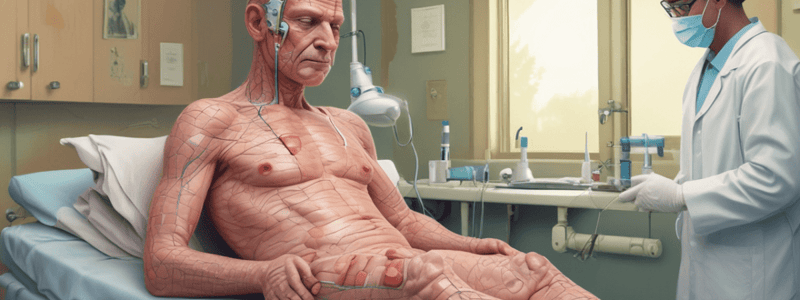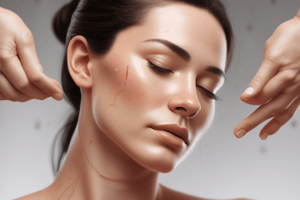Podcast
Questions and Answers
What is the primary advantage of using a full-thickness skin graft?
What is the primary advantage of using a full-thickness skin graft?
- Maximal secondary contraction
- Least resistance to trauma
- Minimal secondary contraction (correct)
- Poor sensation
What is the primary reason for the poor survival of full-thickness skin grafts?
What is the primary reason for the poor survival of full-thickness skin grafts?
- Poor resemblance to original skin
- Poorest survival (correct)
- Donor sites are limited
- Donor site must be closed surgically
During which phase of skin graft healing does revascularization occur?
During which phase of skin graft healing does revascularization occur?
- Phase of revascularization (correct)
- Phase of organization
- Phase of serum imbibition
- Phase of re-epithelialization
What is a critical requirement for graft survival?
What is a critical requirement for graft survival?
Which of the following vitamins is NOT essential for normal tissue repair?
Which of the following vitamins is NOT essential for normal tissue repair?
What is the primary function of oxygen in wound healing?
What is the primary function of oxygen in wound healing?
What is a common complication of diabetes that affects wound healing?
What is a common complication of diabetes that affects wound healing?
What is the primary advantage of using a split-thickness skin graft?
What is the primary advantage of using a split-thickness skin graft?
What is the primary advantage of using a skin graft over a skin flap?
What is the primary advantage of using a skin graft over a skin flap?
What is a major difference between a skin graft and a skin flap?
What is a major difference between a skin graft and a skin flap?
What is the main benefit of using a local flap over a skin graft?
What is the main benefit of using a local flap over a skin graft?
What is the primary disadvantage of using a skin flap?
What is the primary disadvantage of using a skin flap?
What is the classification of a flap based on the type of tissue transferred?
What is the classification of a flap based on the type of tissue transferred?
What is the main goal of a physical therapy program in the pre-grafting stage?
What is the main goal of a physical therapy program in the pre-grafting stage?
What is the main difference between a local flap and a distant flap?
What is the main difference between a local flap and a distant flap?
What is the primary advantage of using a skin flap over a skin graft in terms of aesthetics?
What is the primary advantage of using a skin flap over a skin graft in terms of aesthetics?
What is the primary indication for using an autograft?
What is the primary indication for using an autograft?
What is the primary advantage of using a full-thickness skin graft?
What is the primary advantage of using a full-thickness skin graft?
What is the characteristic of the ideal donor site for skin graft?
What is the characteristic of the ideal donor site for skin graft?
What is the primary indication for using a xenograft?
What is the primary indication for using a xenograft?
What is the characteristic of a split-thickness skin graft?
What is the characteristic of a split-thickness skin graft?
What is the primary indication for using an allograft?
What is the primary indication for using an allograft?
What is the common characteristic of donor sites for skin graft?
What is the common characteristic of donor sites for skin graft?
What is the primary goal of elevation in the post-operative care of skin grafts?
What is the primary goal of elevation in the post-operative care of skin grafts?
When can pressure garments be prescribed for skin graft patients?
When can pressure garments be prescribed for skin graft patients?
What is the purpose of gentle massage in the later stages of skin graft healing?
What is the purpose of gentle massage in the later stages of skin graft healing?
At what stage of healing can some recovery of sensation be noted in skin graft patients?
At what stage of healing can some recovery of sensation be noted in skin graft patients?
What is the sequence of treatment after complete recovery of sensation in skin graft patients?
What is the sequence of treatment after complete recovery of sensation in skin graft patients?
What is the purpose of applying a splint over the pressure garment in skin graft patients?
What is the purpose of applying a splint over the pressure garment in skin graft patients?
When can functional exercises be initiated in skin graft patients?
When can functional exercises be initiated in skin graft patients?
What is the importance of positioning in the post-operative care of skin graft patients?
What is the importance of positioning in the post-operative care of skin graft patients?
What is a factor that can impair healing in patients with chronic renal failure?
What is a factor that can impair healing in patients with chronic renal failure?
What is a complication of skin grafts that can occur later in the process?
What is a complication of skin grafts that can occur later in the process?
What is a goal of physical therapy treatment in the pre-grafting stage?
What is a goal of physical therapy treatment in the pre-grafting stage?
What is a method of treatment used in the pre-grafting stage?
What is a method of treatment used in the pre-grafting stage?
What is a complication of skin grafts that can occur early in the process?
What is a complication of skin grafts that can occur early in the process?
What is a factor that can lead to healing abnormalities?
What is a factor that can lead to healing abnormalities?
What is a goal of physical therapy treatment in the grafting and post-grafting stage?
What is a goal of physical therapy treatment in the grafting and post-grafting stage?
What is a complication of donor sites?
What is a complication of donor sites?
Study Notes
Skin Grafts and Flaps
- Skin graft: a nonvascular skin transfer, taking skin from one part of the body and using it in a different area
- Flap: a portion of skin and/or subcutaneous tissue and muscle, rearranging the skin to fill a hole
Graft vs. Flap
- Graft: does not maintain original blood supply
- Flap: maintains original blood supply
Classifications of Flaps
- According to donor site:
- Local
- Distant
- According to tissue transferred:
- Skin
- Subcutaneous tissue
- Fascia
- Muscle
Indications for Skin Grafts
- Temporary cover:
- To close an open wound
- To prevent infection
- To hasten initial healing
- To prevent exposure of underlying structures
- Permanent cover:
- To provide permanent skin replacement
- To resurface areas of scarring or contractures
Types of Skin Grafts
- According to donor site:
- Autograft: skin transferred from one area of the body to another
- Allograft (homograft): skin from another human (possibly a cadaver), providing temporary cover
- Xenograft (heterograft): animal skin (e.g., pig skin), providing temporary cover
- According to thickness:
- Split-thickness skin graft (STSG): includes epidermis and part of the dermis
- Full-thickness skin graft (FTSG): includes epidermis and entire dermis
Donor Sites for Skin Grafts
- Ideal donor site provides skin identical to the surrounding skin
- Skin varies dramatically from one anatomic site to another in terms of:
- Color
- Thickness
- Hair
- Texture
Healing of Skin Grafts
- Phase 1: serum imbibition (diffusion of nutrition from the recipient bed)
- Phase 2: revascularization (new capillaries start invading the skin graft)
- Phase 3: organization (collagen linkages are made between the wound bed and the graft)
Requirements for Graft Survival
- Well-vascularized bed
- Immobilization of graft and recipient
- Low bacterial count at the site
Factors Affecting Wound Healing
- Age
- Infection
- Nutritional factors
- Vitamins (C, A, E, B, Thiamine) and trace elements (iron, zinc, copper, manganese, calcium, magnesium)
- Oxygen
- Diseases causing impaired wound healing (diabetes, chronic renal failure, liver failure, malignancy, steroids, chemotherapy, radiation)
- Drugs altering immune system
Physical Therapy Treatment for Skin Grafting Patients
- Pre-grafting stage:
- Maintenance of a good airway
- Reduction of edema
- Prevention of structural damage
- Prevention of contracture and deformity
- Maintenance of ROM and strength
- Grafting and post-grafting stage:
- Prevention of structural damage
- Reduction of edema
- Prevention of infection
- Prevention of scar formation
- Increase of ROM and strength
- Improvement of functional activities and walking
Studying That Suits You
Use AI to generate personalized quizzes and flashcards to suit your learning preferences.
Related Documents
Description
Learn about the role of physical therapy in skin grafts and flaps, including types of grafts and flaps, complications, and designing a physical therapy program for pre- and post-grafting stages.




